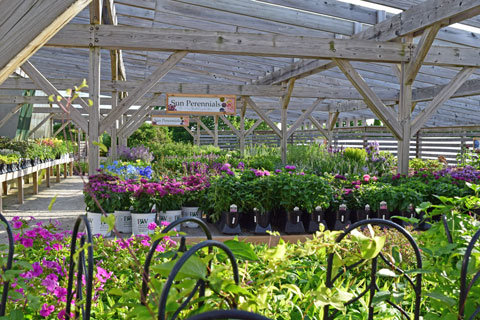5/1/2021
It’s All in the Numbers
Ann-Marie Vazzano

Summertime is bustling in Door County, Wisconsin. During peak season, the coastal community swells with seasonal residents and local nursery Sunnypoint Gardens is the go-to spot for summer homeowners to pick up plants to beautify their getaways.
Ten years ago, Tony and Kori Zawojski bought the business from Tony’s parents, who’d owned it since 1973. In addition to the retail operation, Sunnypoint has 30,000 sq. ft. of covered growing space, where they produce all their own annuals and perennials, as well as the majority of their shrubs.
After running the business for a few years, Tony and Kori began contemplating how they might be able to fine-tune the operation to enhance profitability.
“We knew we were doing OK, but we felt like we needed to refine our vision and thought we could do a little better,” Kori explains.
They decided to join The Garden Center Group. Kori says the biggest benefit that came out of that relationship was learning to focus on inventory and price management, using a back-to-basics approach.
“We started with, ‘What do we do well and how do we do it really well?’” Kori says.
Plants make up 80% of sales, with annuals and perennials being the biggest sellers. The garden center also sells herbs and vegetables, as well as some bagged goods, chemicals and garden tools. “If it doesn’t relate to a plant in some way, we probably don’t sell it,” Kori says.
But it wasn’t always this way and Kori notes they made some hard choices about what stayed and what went. For example, after determining trees weren’t performing well, they abandoned the category altogether. “We determined that we could use that space with a better-performing category more effectively,” Kori explains.
 The gift shop selection was also pared down, as was the depth of selection in the hardgoods department. Instead of carrying three sizes of bagged fertilizer, for example, they determined which two sizes sold best and eliminated the others. In addition, trimming purchasing to match the sales curve throughout the season has improved the bottom line.
The gift shop selection was also pared down, as was the depth of selection in the hardgoods department. Instead of carrying three sizes of bagged fertilizer, for example, they determined which two sizes sold best and eliminated the others. In addition, trimming purchasing to match the sales curve throughout the season has improved the bottom line.
Really digging in to business-wide inventory management also made Kori and Tony realize some changes to the live goods department were necessary. After close inspection, they discovered they were actually over-growing. “We refined that so our inventory turns were better and our stock-to-sales ratio was better,” Kori says.
The Power of POS
The garden center relies on its POS system to evaluate the numbers to better manage inventory. Item sales and inventory reporting sheds light on how fast products are selling in various plant categories. Specifically, Kori runs three date ranges that help keep inventory in check.
“In annuals, we will check sales versus inventory for May 15, June 15 and July 1,” she explains. “We then use this data to help with planning our growing and scheduling for the next season, focusing on timing our plants to be ready to sell when our item sales are increasing, and also making sure not to have too much inventory as the sales season tapers.”
These reports also help forecast how much inventory is necessary to reach revenue growth targets, Kori adds, noting that adaptability is key to keeping the business successful.
“I’m constantly reminded, season by season, how there are always different things that happen—good, bad and ugly sometimes—and you always need to be willing to embrace different ideas and ways of thinking and be willing to try new things,” she says. “That’s always been something we really try to focus on.”
Digging Deep With KPIs
Sunnypoint Gardens’ first step in enhancing profitability was to look at key performance indicators (KPIs). They started by running 12-month margin reports for every department and sorting by margin dollars received for each item. The focus was not on how many items were sold, but rather which ones brought in the most margin dollars. They eliminated inventory in the bottom 10% and addressed anything in the bottom 15%. They were then able to focus on fine-tuning inventory management of the best-performing items.
About This Series
In 2021, we will feature a different garden retailer each month from The Garden Center Group’s Best Practices group. These retailers achieved 10% or more profit in the previous year (the first couple of features are from the 2019 Best Practices Group). The Garden Center Group offers Weekly Department Reviews, as well as an Annual P&L Study for those clients who wish to participate. Both are actionable reports that retailers can use to benchmark off of and grow sales in specific categories. Find out more at www.thegardencentergroup.com.